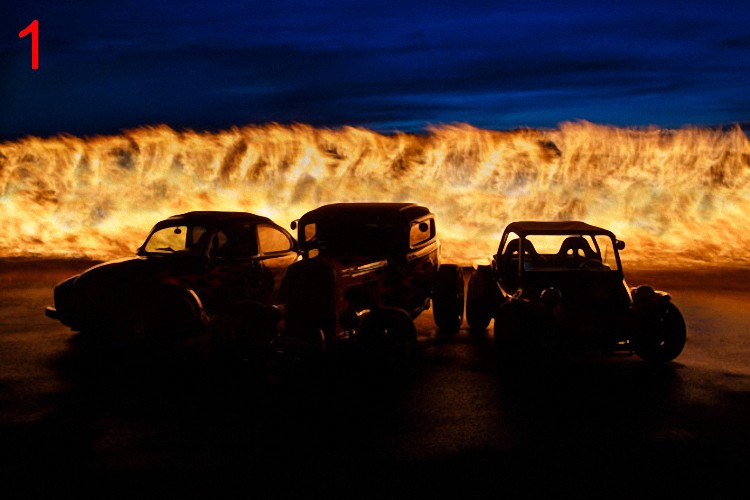In this article, see how the shot below was conceptualized, shot and put together and finished in post-processing.

The idea
It all begun with the first picture I did of the customer’s hot rod. He wanted a print on his wall (about 2×3 meters). So, I used my large format camera, a Linhof Master Techika, with sheet film. We did a large scan of the negative and the huge print of that scan.

This huge print from a 4×5 negative looks great even from up close.
Then the customer painted two other cars in the same style as the hot rod.

Cool cars with pin striped flames.
He called and asked me to do a group shot and if I had any ideas how to do it. I thought about it a while and came up with the idea of light painting fire in the background, but I wanted to light the cars perfectly. I also had a reflection of the fire and the cars in my mind.
Safety first
We found a huge asphalt place, where we were far away from anything flammable and we could use water on the ground for the reflection. But before I go into detail, I want to tell you about the safety part. Safety was the most important part of this shoot and it took a lot of time to plan everything.

Always be careful with fire.
Here is a safety checklist for you:
- You must get a permission to shoot at the selected location.
- Everybody should wear cotton shirts and jeans – these materials can be extinguished easily in case of fire.
- Get a fireproof suit for your assistant (ask your fire department).
- Talk with your fire department before the shoot, they have lots of knowledge about fire safety. Also find out if you need a fire permit.
- Have enough people on the set (one who carries the fire wick and one who kills the fire).
- Have a fire extinguisher onsite and know how to use it (also get a fire blanket).
- Gas tanks of old cars are mostly leaky, and at warmer temperatures they vaporize gas. So be sure to have enough distance between the cars and the fire – talk to car mechanic before the shoot about the risks.
- Wet sheets and lots of extra water.
- If it is too windy cancel the shoot – it’s difficult to control fire in windy conditions.
How the shot was done

This is how the setup looked.
I arranged the cars hours before sunset and set my camera on a tripod. In order to get a better idea of the outcome, I shot tethered to my laptop. After everything was in place, I started shooting the cars while the strobe was moved all around the cars. With all these different shots, I could get a reflection free exposure of all cars in post-production.

Here you can see all the single exposures.
After this was done we poured about 200 litres of water on the ground to make the reflection. Again I took multiple exposures of the reflection with the strobe.

Same procedure again.
The fire
After I did a separate shot of the lights, I was waiting for blue hour to do the fire light painting. For that we used a 3-meter-long wick (a Kevlar wick is the one you want to buy) mounted on a long metal stick. We soaked the wick with lamp oil, in a metal pot (use one that you can cover with a lid if it catches fire) far away from the place where we fired it up.
Then I started with a long exposure (using a cable release on my camera) while one assistant walked behind the cars with the huge fire wick. At the end, the second one killed the fire with the wet sheets. As you can imagine, this is a very time critical task to get everything done during blue hour.

This is how the fire painting looked.
Gear used:
- Canon EOS 5D MK III
- Canon EF 35mm 1.4 L USM
- Canon Timer Release TC-80N3
- Linhof tripod and ballhead
- Hensel Expert D 1000 Strobe
- Hensel Grand 90 Softbox
- Hensel Power Max L mobile power generator
- Hensel aluminum tripod
Post-processing
I’m a long-time Photoshop user, but changed to Affinity Photo since my CS6 license was only valid on Windows and not on my new Mac. First it was a try, but now I do everything in Affinity Photo. I just love it – even the iPad app, that could also open my 1.2 gig hot rod file.
Step by step:
I used the fire painting image as the background (1 below). Then I put all the other layers above using layer masks and painted everything in one by one.

First the headlights (2) then the cars starting with the Dune Buggy (3,4,5) to the Hot Rod (6-7) and at the end VW Beetle (8,9).








Now I put a layer mask above all the cars, deleted some of the parts that were too shiny and painted flame reflections from the background back in (10). At the end, I painted the reflections into the picture to make everything complete (11).


As you can imagine there were lots of layers to work with and in total I worked 11 hours (including preparation and shooting) on this one photograph.

Every layer with its own layer mask.
Final image
Not everyone will have the resources, skills or ability to do a shot like this. Please remember, do not attempt this without advise from safety professionals.
But I hope you agree that all the time and effort that went into this shot is worth it.

The post Hot Rod Flame for Flame – How the Shot was Made by Markus Hofstaetter appeared first on Digital Photography School.